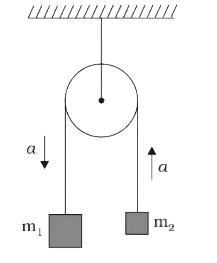Correct expression for density of an ideal gas mixture of two gases 1 and 2, where m1 and m2 are masses and n1 and n2 are moles and M1 and M2 are molar masses.
d=(m1+m2)(M1+M2)
d=(m1+m2)(n1+n2)PRT
d=(n1+n2)(m1+m2)×PRT
None of these
The correct Answer is:b
To derive the correct expression for the density of an ideal gas mixture of two gases (1 and 2), we will follow these steps:
Step 1: Understand the definition of density
Density (ρ) is defined as mass (m) per unit volume (V):
ρ=mV
Step 2: Calculate the total mass of the gas mixture
For the mixture of two gases, the total mass (m_total) is the sum of the masses of the individual gases:
mtotal=m1+m2
Step 3: Use the ideal gas law to find the volume
According to the ideal gas law, the relationship between pressure (P), volume (V), number of moles (n), gas constant (R), and temperature (T) is given by:
PV=nRT
For the gas mixture, the total number of moles (n_total) is:
ntotal=n1+n2
Thus, the volume of the gas mixture can be expressed as:
V=ntotalRTP=(n1+n2)RTP
Step 4: Substitute the total mass and volume into the density formula
Now we can substitute the expressions for total mass and volume into the density formula:
ρ=mtotalV=m1+m2(n1+n2)RTP
Step 5: Simplify the expression
Rearranging the expression gives us:
ρ=(m1+m2)P(n1+n2)RT
Step 6: Relate mass and moles to molar mass
We can express the masses in terms of moles and molar masses:
m1=n1M1andm2=n2M2
Substituting these into the density equation:
ρ=(n1M1+n2M2)P(n1+n2)RT
Final Expression
The final expression for the density of the ideal gas mixture is:
ρ=(n1M1+n2M2)P(n1+n2)RT
Density (ρ) is defined as mass (m) per unit volume (V):
ρ=mV
For the mixture of two gases, the total mass (m_total) is the sum of the masses of the individual gases:
mtotal=m1+m2
According to the ideal gas law, the relationship between pressure (P), volume (V), number of moles (n), gas constant (R), and temperature (T) is given by:
PV=nRT
For the gas mixture, the total number of moles (n_total) is:
ntotal=n1+n2
Thus, the volume of the gas mixture can be expressed as:
V=ntotalRTP=(n1+n2)RTP
Now we can substitute the expressions for total mass and volume into the density formula:
ρ=mtotalV=m1+m2(n1+n2)RTP
Rearranging the expression gives us:
ρ=(m1+m2)P(n1+n2)RT
We can express the masses in terms of moles and molar masses:
m1=n1M1andm2=n2M2
Substituting these into the density equation:
ρ=(n1M1+n2M2)P(n1+n2)RT
The final expression for the density of the ideal gas mixture is:
ρ=(n1M1+n2M2)P(n1+n2)RT
Topper's Solved these Questions
- GASEOUS STATEBOOK - NARENDRA AWASTHI ENGLISHCHAPTER - GASEOUS STATEEXERCISE - Level 3 Passage 1
4 Videos
- GASEOUS STATEBOOK - NARENDRA AWASTHI ENGLISHCHAPTER - GASEOUS STATEEXERCISE - Level 3 Passage 2
6 Videos
- GASEOUS STATEBOOK - NARENDRA AWASTHI ENGLISHCHAPTER - GASEOUS STATEEXERCISE - Subjective problems
15 Videos
- ELECTROCHEMISTRYBOOK - NARENDRA AWASTHI ENGLISHCHAPTER - ELECTROCHEMISTRYEXERCISE - Subjective problems
14 Videos
- IONIC EEQUILIBRIUMBOOK - NARENDRA AWASTHI ENGLISHCHAPTER - IONIC EEQUILIBRIUMEXERCISE - Subjective problems
1 Videos
Similar Questions
Two bodies of masses m1andm2(<m1) are connected to the ends of a massless cord and allowed to move as shown in figure. The pulley is both massless and frictionless. The acceleration of the centre of mass is (m1−m2)n(m1+m2)2g. Find the value of n.

View SolutionThe degree of freedom of mixture of two ideal gases having moles n1 and n,2 and degree of freedom f1 and f2 respectively, is
View Solution
Knowledge Check
Two particles A1andA2 of masses m1,m2(m1>m2) have the same de-broglie wavelength. Then
Atheir momenta are the same.Btheir energies are the same.Cmomentum of A1 is less than the momentum of A2.Denergy of A1 is more than the energy of A2.
Supposing Newton's law of gravitation for gravitation forces F1 and F2 between two masses m1 and m2 at positions r1 and r2 read
where M0 is a constant of dimension of mass, r12=r1−r2 and n is a number. In such a case,
View SolutionThe expression relating mole fraction of solute (χ2) and molarity (M) of the solution is: (where d is the density of the solution in gL−1 and Mw1 and Mw2 are the molar masses of solvent and solute, respectively
View SolutionTwo perfect gases (1) and (2) are at temperatures T1 and T2 . If the number of molecules of the two gases are n1 and n2 and the masses of the molecules m1 and m2, find the resulting temperature when the two gases are mixed. Assume that there is no loss of energy on mixing the two gases.
View SolutionThe molecular velocities of two gases at same temperature are u1 and u2, their masses are m1 and m2 respectively, which of the following expression is correct ?
View SolutionThe molecular velocities of two gases at same temperature are u1 and u2, their masses are m1 and m2 respectively, which of the following expression is correct ?
View SolutionTwo particles A1andA2 of masses m1,m2(m1>m2) have the same de-broglie wavelength. Then
View SolutionTwo identical containers A and B having same volume of an ideal gas at same temperature have mass of the gas as m1 and m2 respectively and 2m1=3m2. The gas in each cylinder expands isomthermally to double of its volume. If change in pressure in A is 300Pa, then the change in pressure in B is
View Solution
